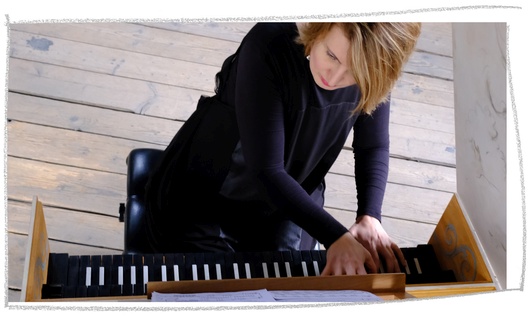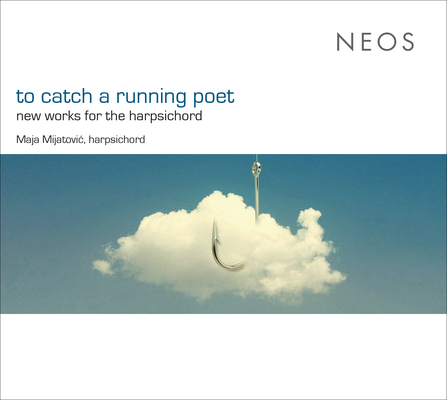Released: February 22, 2019 NEOS 11906
==> LISTEN <==
Reviews - Kritiken - Kommentare

German Record Critics' Award
for
to catch a running poet
German Record Critics' Award
for
to catch a running poetJury statement:
György Ligeti's Continuum for harpsichord from 1968 and the piece Khoai by Iannis Xenakis, composed in 1976, have long been classics, written half a century ago. How good that Maja Mijatović has asked eight contemporary composers to write something new for her old instrument. The results are breathtaking, because the album leads the listener to an experimental field for new sounds. Sometimes they are percussive thunderclaps, threatening and insistent, sometimes magical, untouched islands of infinite grace. Pure sound exploration!
(For the jury: Martin Hoffmann)
At the end of each year, Fono Forum asks its critics: Which five CDs impressed you the most last year?
Friedrich Sprondel chose "to catch a running poet", and justified this by saying
"An interpreter who seems to burst with curiosity and the desire to play, an excellent harpsichord - and music that explores it in ever new and fascinating ways".
Fono Forum, January 2020

Virtuous, daring, innovative
Yvonne Petitpierre in Die neue Platte - Reizvolle Klangexperimente - Neue Musik für Cembalo, Deutschlandfunk, 8.9.2019

It is sensational with which empathy and technical diversity the harpsichordist opens up new listening spaces.
Margarete Zander about „To catch a running poet“, in Das Cembalo in der Neuen Musik, Musik der Gegenwart, rbbKultur, 17. 7. 2019
Ettore Garzia on Percorsi Musicali, webzine on contemporary music
http://www.percorsimusicali.eu/2019/07/08/un-clavicembalo-corre-veloce-nelle-pieghe-dellattualita/
A harpsichord moves fast in the modernity arena
During an interview for Austrian Music Export, the harpsichordist Sonja Leipold was asked who the contemporary pioneers of the harpsichord were. Leipold’s concise and witty answer was:
"… the revival of the harpsichord actually began in the 1920s, when Wanda Landowska began working with contemporary composers such as Poulenc, de Falla and others. Elzbieta Chojnacka and Antoinette Vischer were other important European pioneers, in whose circle works by Xenakis, Berio, Haubenstock-Ramati, Brown, Carter, Glass, Sciarrino, Ligeti, Saariaho, Gubaidulina, etc. were written. Goska Isphording from Amsterdam has been a very influential contemporary harpsichordist for about 15 years. In Austria it is Maja Mijatović …" (Ruth Ranacher – translated from the German interview by Dave Dempsey).
This passage helped me to dwell on the latter harpsichord performer mentioned by Leipold. The occasion is a CD for NEOS Music with the wonderful title: To catch a running poet
In the difficulties that the contemporary repertoire for harpsichord suffers from a strange and insufficient initiative of the protagonists who govern it (composers interested in writing and specialized musicians who require repertoire), it is developing a sort of redemption of ancient music for harpsichord, the one of Frescobaldi’s period, Froberger, Buxtehude, Bach, Couperin, Rameau; the insertions of the past in modern harpsichord music often occur taking into account that the techniques have changed and that it is obvious that you can use the instrument even in an extensive way.
The reality is that when we go into detail, we hardly see those giants again, because not even a well-focused magnifying glass would be able to bring them back to us. There is a clash between the timbre of an ancient instrument and an ultra-modern language. The necessary tolls to pay to move forward.
Maja Mijatović is therefore a messenger of the times, like the duplex scanning of a sheet of paper in which the two sides are written in a different language, while remaining on the same material: the paper used is the same, but as soon as we turn the page we feel an extreme climate change.
To catch a running poet is the most reckless side of the paper, the one that collects 9 recent projects (predominance of those composed between 2014 and 2017), set up by composers attracted by what Hannes Dufek calls in the liner notes "experimental arrangement of leaps in time", a precise definition that captures the abstractness of the late Renaissance and Baroque references; those were resuming affections, these of Mijatović could represent alienations.
But it's not the poetic momentum that's being compromised: you go nervous like a crazy clock in Ištaratu by composer Margareta Ferek-Petric or you look for replicas of existence with “Ostinatos” and preparations conducted in combination between keyboard and interior of the instrument in Empty-forms by Rafael Nassif; we go hunting for relationships with the reappearances of a tape that holds pre-recorded harpsichord sounds, creating a microtonal spectrum in Peter Jakober's Dringen or we work on a semblance of life, struggling with a rubbing textureon the strings in Tamara Friebel's Dance me to my rebirth.
Ultimately, in To catch a running poet the harpsichord actually takes nine different solver goals, all provocations of the musical techniques and parameters that are difficult to find in the ordinary schedule of concerts. They offer a rather valid alternative to piano preparations and reflect the value of Mijatovic, who makes the harpsichord play wonderfully all the times, while hoping that someone will notice a circumstance, namely the fact of placing a stake in unexplored territories of the instrument.
(Translation: Alessandro Zanon)











